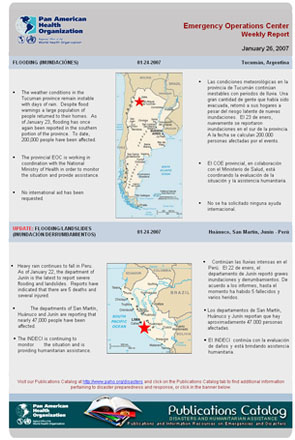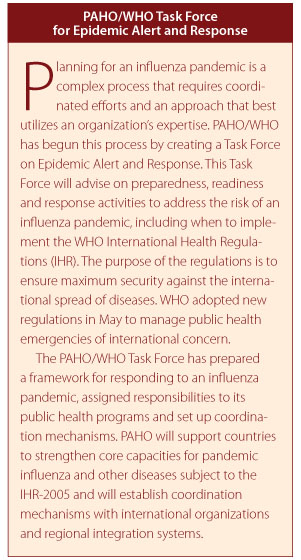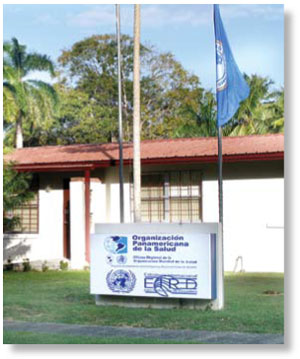4. Building Disaster Response Capacity in PAHO/WHO
When PAHO’s Directing Council created the Area on Emergency
Preparedness and Disaster Relief, it asked for assistance to strengthen
the national response capacity of member states through the efficient
use of existing resources. Over the years, the scope of this request
has expanded to include assisting countries to reduce the health
sector’s risk to natural hazards. The range of requests
for technical cooperation continues to grow: the methanol intoxication
in Nicaragua, the humanitarian aspects of pandemic influenza and
the civil strife in Bolivia are recent examples of the variety
of the demand. It is expected that this trend of increasing requests
for technical cooperation will continue to grow or even accelerate,
as the public’s expectation that governments will respond
to, or even prevent disasters increases. This reality is coupled
with expectations from the international community that countries
should have institutions capable of handling all aspects disaster
management—even mega-events like the tsunami. To face these
demands, PAHO/WHO will strike a balance in its technical cooperation,
focusing on: a) risk reduction—the developmental side of
disaster technical cooperation that must be addressed on a day-to-day
basis as a long-term target; and, b) disaster response—whose
short-term but highly effective actions require quick and flexible
mechanisms.
PAHO Headquarters Emergency Operations
Center
 PAHO
is a development agency and not a humanitarian organization. However,
the health sector, and in particular, the Ministries of Health,
do expect PAHO to be by their side in disaster situations. The
international community also turns to PAHO/WHO for health information,
guidance and coordination. In order for PAHO to continue playing
a leadership role in disaster response and to meet the expectations
of partner countries and donors, the Organization must provide
reliable, up-to-date and authoritative information during emergency
and disaster situations. To fulfill its mandate, even in cases
where the Organization’s operational capacity may be affected,
PAHO’s Director called for the establishment of an emergency
operations center (EOC) in Washington DC to mobilize and coordinate
the necessary resources at the headequarters and field level.
The EOC is the physical location established to coordinate this
overall response. It collects, receives, organizes, analyzes,
prioritizes, monitors, and disseminates information about health
crises or emergencies to enable decisionmaking and to support
Member Countries and the international community.
PAHO
is a development agency and not a humanitarian organization. However,
the health sector, and in particular, the Ministries of Health,
do expect PAHO to be by their side in disaster situations. The
international community also turns to PAHO/WHO for health information,
guidance and coordination. In order for PAHO to continue playing
a leadership role in disaster response and to meet the expectations
of partner countries and donors, the Organization must provide
reliable, up-to-date and authoritative information during emergency
and disaster situations. To fulfill its mandate, even in cases
where the Organization’s operational capacity may be affected,
PAHO’s Director called for the establishment of an emergency
operations center (EOC) in Washington DC to mobilize and coordinate
the necessary resources at the headequarters and field level.
The EOC is the physical location established to coordinate this
overall response. It collects, receives, organizes, analyzes,
prioritizes, monitors, and disseminates information about health
crises or emergencies to enable decisionmaking and to support
Member Countries and the international community.
Currently, the EOC in PAHO has been equipped with the necessary
office resources to effectively functions as an information management
system to monitor emergency or disaster events that may require
an international health response. In non-disaster situations,
it monitors and identifies other health crises that may require
an Organization-wide response. The EOC provides meeting space
for inter-divisional planning or monitoring.
In 2006, PAHO’s EOC began publishing a weekly electronic
bulletin of reported incidents or updates of currently monitored
events of concern in the Region. Additionally, the EOC has fostered
an exchange of technical information and feedback through formal
debriefings to PAHO and other outside officials, through presentations
on response operations from specific events. This year, a medical
toxicologist, identified by PAHO to assist the MoH of Nicaragua
and Panama following the mass intoxications with methanol and
diethylene glycol, briefed the Organization at the conclusion
of his assignment. This presentation fostered an understanding
within the Organization of the many different types of issues
involved in response to crises.
By the end of 2006, plans were underway to expand the EOC and
incorporate it into a planned PAHO Knowledge Center. As conceived,
the Knowledge Center will serve as the communication hub of regional
alert and response operations, providing rapid access to information;
supporting field operations; improving internal and external collaboration
and coordination; strengthening national alert and response capacities;
and offering dynamic access to key health data for priority diseases
and health interventions. This will be an important thrust of
the Organization’s work in the coming year.
Corporate Capacity Building
- Corporate Capacity
Building for Managers
 One
of PAHO’s Strategic Objectives calls for strengthening
disaster preparedness, management and response within the
PAHO.WHO. However, reducing the impact of disasters on the
health sector of PAHO/WHO Member States is too big a job for
any one Area alone. The collaboration and technical expertise
of the entire Organization is key and an approach to risk
management and vulnerability reduction must be incorporated
into traditional development activities. To take a step in
this direction, in 2006 PAHO/WHO planned a series of meetings
for senior managers (all PAHO/WHO Representatives, Area Managers
and other selected senior staff) at headquarters and in field
offices to improve the Organization’s capacity to include
elements of risk reduction in all technical cooperation programs
and to strengthen the corporate response capacity to better
assist countries affected by emergencies and disasters. The
Global Learning Fund of the World Health Organization provided
financing for this initiative, which will help to define senior
and executive management’s roles and responsibilities.
One
of PAHO’s Strategic Objectives calls for strengthening
disaster preparedness, management and response within the
PAHO.WHO. However, reducing the impact of disasters on the
health sector of PAHO/WHO Member States is too big a job for
any one Area alone. The collaboration and technical expertise
of the entire Organization is key and an approach to risk
management and vulnerability reduction must be incorporated
into traditional development activities. To take a step in
this direction, in 2006 PAHO/WHO planned a series of meetings
for senior managers (all PAHO/WHO Representatives, Area Managers
and other selected senior staff) at headquarters and in field
offices to improve the Organization’s capacity to include
elements of risk reduction in all technical cooperation programs
and to strengthen the corporate response capacity to better
assist countries affected by emergencies and disasters. The
Global Learning Fund of the World Health Organization provided
financing for this initiative, which will help to define senior
and executive management’s roles and responsibilities.
By the end of the year, senior staff had begun to complete
a pre-workshop survey to identify gaps in knowledge and areas
they feel require further explanation. An agenda was prepared
and circulated for comment and finalized by the end of the
year (Annex
13). Speakers were also identified. The workshops will
provide an opportunity to discuss a number of important issues:
UN humanitarian reform; pandemic influenza; regional disaster
policies; PAHO/WHO emergency response; resource mobilization
and project management; crisis communications; core competencies
for disaster risk reduction and more.
Even before planning began for the corporatewide training
initiative, many PAHO/WHO technical areas and country offices
had already organized and/or contributed to a wide variety
of disaster reduction and response activities. In 2006, the
country office in Nicaragua provided an example of this type
of involvement.
- Nicaragua
is no stranger to disasters and the PAHO/WHO country office
has had to deal with many of them. In 2005, Hurricane Beta provided
the impetus needed to improve and update the emergency skills
of technical staff, standardize the understanding of roles and
procedures in the event of an emergency and develop an internal
disaster response plan. In April, the PAHO/WHO Office organized
staff training, beginning with a review of the principal natural
hazards that make Nicaragua vulnerable, the key actors both
nationally and in the subregion and a discussion of what the
roles and responsibilities of each staff member would be in
emergency situations. Subsequently, a simulation exercise was
held in which all administrative and technical personnel were
obliged to work together as a team, produce high-quality, timely
and reliable information for decision making and gain a better
understanding of how the health sector must interact with other
sectors. The adjustments made to the PAHO/WHO internal emergency
plan helped the Organization provide better support to the MoH
in subsequent disasters. The simulation is also serving as a
model for other PAHO/WHO country offices.
Because disaster reduction has become such a complex business,
it is clear that achieving the Organization’s goals in this
field requires the fulltime dedication of a network of professionals.
Each PAHO/WHO Representation in Latin America and the Caribbean
has a disaster focal point,
selected from among the professional staff, to assume some responsibility
for planning and executing disaster reduction activities at country
level. For a variety of reasons—the economic situation,
national priorities, political goodwill—the level of involvement
varies from country to country. But nonetheless, this network
is invaluable and is completely without cost to the core budget
of PED. As PAHO/WHO staff they can negotiate with the Ministries
to ensure that risk reduction activities are included in the country
technical cooperation program. The list of PAHO/WHO disaster focal
points based in member countries is attached in Annex 14.
Move to Panama Strengthens Relations with
UN Family
 PAHO/WHO
relocated its Central American disaster office from Costa Rica
to Panama at the start of 2006 to strengthen ties with UN agencies
that have their regional offices in that country (see note on
REDLAC under the Partnerships section of Chapter 1). Within the
UN, PAHO/WHO is responsible for health sector response—responsibility
for water and sanitation is shared with UNICEF. Since PAHO/WHO
is the only REDLAC member with offices in each country of the
Region (with the exception of UNDP—which acts primarily
in early recovery phase), the Organization provided support for
in-country contacts and activities to other REDLAC members. To
have adequate staffing to meet the challenges and opportunities
that present themselves through this structure, the Area on Emergency
Preparedness and Disaster Relief reinforced its new office in
Panama by transferring two senior regional advisors in order to
improve coordination and information management. In the future,
all response operations, including the mobilization of the Regional
Health Disaster Response Team, will be run out of the Panama office.
PAHO/WHO
relocated its Central American disaster office from Costa Rica
to Panama at the start of 2006 to strengthen ties with UN agencies
that have their regional offices in that country (see note on
REDLAC under the Partnerships section of Chapter 1). Within the
UN, PAHO/WHO is responsible for health sector response—responsibility
for water and sanitation is shared with UNICEF. Since PAHO/WHO
is the only REDLAC member with offices in each country of the
Region (with the exception of UNDP—which acts primarily
in early recovery phase), the Organization provided support for
in-country contacts and activities to other REDLAC members. To
have adequate staffing to meet the challenges and opportunities
that present themselves through this structure, the Area on Emergency
Preparedness and Disaster Relief reinforced its new office in
Panama by transferring two senior regional advisors in order to
improve coordination and information management. In the future,
all response operations, including the mobilization of the Regional
Health Disaster Response Team, will be run out of the Panama office.
Conclusion
Progress cannot be measured without a baseline for comparison.
Therefore, one of the key achievements of the year is the survey
of the Region on National and Regional Health Disaster Preparedness
and Response conducted to assess the status of the region. While
the resulting figures indicate that there is still much progress
yet to be achieved, this data provides a valuable gauge for long
term advances and for focusing priorities in the immediate future.
While 2005 represented the most active hurricane season recorded
in the region, 2006 was significantly less active, allowing the
Program to intensify preparedness and mitigation efforts through
trainings, publications, enhancing partnerships, developing new
tools for hospital safety assessments and building internal capacity.
Building capacity throughout the region through various types
of trainings serves to improve overall preparedness for other
scenarios, including the Cricket World Cup or other mass events.
Trainings in 2006 including such courses as: LEADERS, pandemic
influenza, mass casualty management, damage and needs assessments,
LSS/SUMA and improving internal corporate capacity coordination.
Responding to all types of health crises, PAHO/WHO coordinated
prompt and effective response, reducing deaths, and alleviating
the adverse health effects. Disaster response operations were
improved through the transfer of key personnel to Panama for increased
coordination with other humanitarian actors in the Region.
Future opportunities lie in continued collaboration on publications
and preparing for and implementing the upcoming Safe Hospitals
campaign. In 2007, PAHO mitigation activities will focus on launching
the 2008 Safe Hospitals Campaign by building partnerships both
within PAHO and outside.

